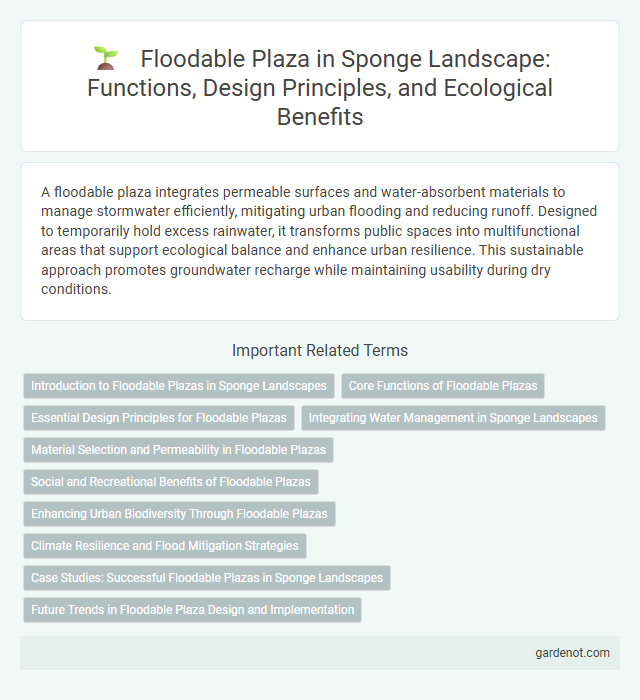A floodable plaza integrates permeable surfaces and water-absorbent materials to manage stormwater efficiently, mitigating urban flooding and reducing runoff. Designed to temporarily hold excess rainwater, it transforms public spaces into multifunctional areas that support ecological balance and enhance urban resilience. This sustainable approach promotes groundwater recharge while maintaining usability during dry conditions.
Introduction to Floodable Plazas in Sponge Landscapes
Floodable plazas in sponge landscapes serve as multifunctional urban spaces designed to absorb and temporarily store excess stormwater, reducing flood risks and improving water quality. These plazas integrate permeable surfaces, submerged basins, and vegetation to enhance infiltration and delay runoff, promoting sustainable urban drainage. Effective floodable plaza design contributes to resilient cities by balancing aesthetic appeal with critical flood management functions.
Core Functions of Floodable Plazas
Floodable plazas serve as multifunctional urban spaces designed to temporarily store and manage stormwater during heavy rainfall, reducing flood risks in densely populated areas. These plazas incorporate permeable surfaces and retention basins that absorb and slow runoff, enhancing groundwater recharge and minimizing strain on municipal drainage systems. By integrating greenery and seating areas, floodable plazas also promote social interaction and improve urban aesthetics while fulfilling critical flood mitigation functions.
Essential Design Principles for Floodable Plazas
Floodable plazas integrate permeable surfaces and elevated walkways to manage stormwater effectively while ensuring public accessibility during floods. Utilizing native vegetation and bioswales enhances water absorption and reduces runoff, promoting ecological resilience. Designing for multifunctionality, these plazas combine public gathering spaces with flood control infrastructure to optimize urban flood management.
Integrating Water Management in Sponge Landscapes
Floodable plazas serve as crucial components in sponge landscapes by temporarily storing and managing excess rainwater during heavy storms. These plazas utilize permeable surfaces and designed depressions to facilitate infiltration, reduce runoff, and prevent urban flooding. Integrating natural vegetation and smart drainage systems enhances water retention and contributes to sustainable urban water management.
Material Selection and Permeability in Floodable Plazas
Selecting materials for floodable plazas requires prioritizing high permeability to enhance water absorption and reduce surface runoff. Porous pavements such as permeable concrete, permeable pavers, and reinforced grass offer optimal infiltration rates, facilitating effective stormwater management. Integrating natural materials like gravel and permeable soils further improves drainage, supporting sustainable urban water cycles in sponge landscapes.
Social and Recreational Benefits of Floodable Plazas
Floodable plazas enhance urban resilience by providing multifunctional spaces that absorb excess rainwater while serving as vibrant social hubs. These areas encourage community interaction through recreational activities such as markets, performances, and festivals, even during dry periods. Integrating green infrastructure with flood management, floodable plazas promote environmental education and well-being, fostering stronger social cohesion in urban settings.
Enhancing Urban Biodiversity Through Floodable Plazas
Floodable plazas serve as multifunctional urban spaces that manage stormwater while creating diverse habitats for native flora and fauna. By integrating permeable surfaces and native vegetation, these plazas support pollinators, birds, and amphibians, significantly boosting urban biodiversity. Strategic water retention in floodable plazas also mitigates flood risks and fosters resilient ecosystems within densely populated areas.
Climate Resilience and Flood Mitigation Strategies
Floodable plazas enhance urban climate resilience by temporarily storing excess stormwater during heavy rainfall events, reducing surface runoff and minimizing flood risk. These multifunctional spaces incorporate permeable pavements, bio-retention areas, and subtle grading to direct and absorb floodwaters effectively. Implementing floodable plazas supports sustainable urban drainage systems, mitigating urban heat and improving water quality through natural filtration.
Case Studies: Successful Floodable Plazas in Sponge Landscapes
Floodable plazas in sponge landscapes, such as the Benthemplein Water Square in Rotterdam, demonstrate effective urban water management by temporarily storing excess rainwater during storms, thereby reducing flood risks. These plazas integrate porous pavements and green infrastructure to enhance water absorption and slow runoff, improving local water cycles. Case studies reveal that multifunctional designs combining recreational spaces with stormwater retention optimize both community use and climate resilience.
Future Trends in Floodable Plaza Design and Implementation
Future trends in floodable plaza design emphasize adaptive infrastructure using porous materials and integrated green technologies to enhance stormwater management. Smart sensors and IoT systems are increasingly implemented for real-time water level monitoring and automated drainage control, improving resilience against urban flooding. Design strategies also prioritize multifunctional spaces that combine recreational uses with flood mitigation, fostering community engagement while effectively managing excess water.
Floodable plaza Infographic

 gardenot.com
gardenot.com